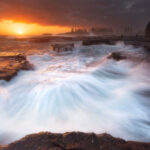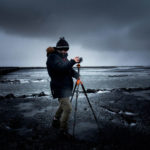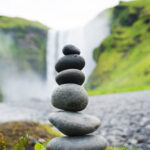Amateurs and pros alike face the fact that slower shutter speeds and camera shake lead to blurred images. This tutorial by David Bergman demonstrates some of the main reasons for camera shake and how to overcome them:
Camera Shake Rule of Thumb
The old school rule of thumb about camera shake is that as long as the denominator of the shutter speed is bigger than the focal length, you can avoid image blur. That means that if you’re shooting at 50mm, you should select at least a shutter speed of 1/50 of a second or faster to get a blur-free image. In the real world, the wider the focal length, the less the camera shake.

Modern lenses come with built-in image stabilization and selectable ISO. These are great in terms of speeding up the shutter speed and getting blur-free images.
Body Positions to Prevent Camera Shake
There are a host of techniques that you can adapt in order to minimize camera shake.
First, keep one hand underneath the lens barrel (as demonstrated below) in order to stabilize it.

Keep one hand under the lens.
Tuck your elbows in to your body to reduce movement.
Spread your feet slightly so you’re properly balanced.
If possible, lean against a wall or a tree for additional support.
Take slow, deep breaths and press the shutter release at the end of your exhale.
Look through the viewfinder instead of at the LCD screen to compose shots. Holding your camera up against your faces gives you an extra bit of support.
If you have to use the back LCD screen, use the camera neck strap and hold it as far and as hard as you can. It should give you some leverage to get sharp clean video footage.

Make use of your neck strap.
Finally, if you’re still plagued by the problem of camera shake, set your camera to burst mode and fire away as many shots as you can. Chances are you will get at least a few frames that are perfectly sharp.
Do you have any tips to add?
Like This Article?
Don't Miss The Next One!
Join over 100,000 photographers of all experience levels who receive our free photography tips and articles to stay current:











You did not mention the first and most important point which is to squeeze rather than jab the shutter button. That is always the mistake most newcomers make.
Aso remeber that the old school rule of thumb applies to full-frame cameras and that with an APSC (for example) you have to apply it differently as, for example, a 50mm is the equivalent of an 80mm.
Trick from the (true, swing lens) panoramic cameras: bend forward with the camera hanging from your neck, and push down on the camera. Little tricky since most SLR’s don’t bother with leveling aids, but it can buy you two or three stops if you take the time to get used to looking at the top of your camera.
Just another tip:
Make a double strap of paracord. Clip it an the bottom of the camera. Put your legs in the strap en spread your legs. Yout have a sort of a triangle. And this give the camera extra hold. I have one in my case.
Excellent article! I sometimes find that using any in-camera photo combining effects often help when there’s no tripod around. For example, my camera, Panasonic G7, has two such effects. One is HDR where the camera combines two or more images. And another is called Hand Held Night Shot. This one is found in the Scene Mode. The first one can be found in the menu.
There’s also the Panarama Mode which is useful too when you left your fish eye at home.
Right before I shoot, I take a breath and hold it, but for more than a few seconds. This may not work for everyone, but it reduces another source of movement.
Tip from my sixth-grade air rifle class: Fire between the exhale and the inhale; your tense up when your lungs are full, but you’re less likely to move when you’re relaxed.
I shoot on a long, relaxed exhale. It works well for me.